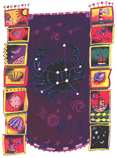 |
Search the site:

|
Cancer, constellation of
While the great hero Hercules was fighting the many-headed Hydra, Cancer is the fourth sign and the fifth constellation of the zodiac and the Sun appears to pass through this region of the sky between the end of July and the end of August. Astrologers linked the shy, retiring nature of the creature to those born under its sign. Although relatively small and with few bright stars Cancer is still interesting, mainly for a beautiful, if faint, star cluster lying deep in its heart. This group has perhaps fifty stars at a distance of some 520 light years. Through binoculars the stars appear to be buzzing around a honey pot, the centre of the cluster, giving rise to its popular name, the Beehive Cluster. In ancient times, though, it was known as the Manger and the two stars which stand on guard by it were called the Northern and the Southern Asses. The Greek poet, Aratus, who wrote the earliest remaining complete description of the sky, mentions the Manger as a forecaster of weather. If the cluster cannot be seen, while other nearby stars are in view, then rain is predicted since even a small amount of moisture in the air is enough to obscure this very faint group. In the time of the ancient Greeks, the Sun was in the constellation of Cancer when it reached its most northerly point in the sky. This day is known as the summer solstice as the Sun appears to stand still for a short time before apparently turning south again. At this point the Sun appears directly overhead at midday at the latitude of 23.5° north of the Equator, a line of latitude which became known as the Tropic of Cancer. Since then, however, the situation has changed. The Earth wobbles a little as it turns on its axis, rather like a spinning top. Although it is rather a slow wobble, over thousands of years its effects become noticeable. One particular result is that the annual positions of the Sun have changed and the summer solstice now occurs when the Sun is in the constellation of Gemini. The Tropic of Cancer, though, has retained its original name. From the Appletree Press title: A Little Book of Stars.
|
[ Back to Top ]
All Material © 1999-2004 Irelandseye.com and contributors

 guardian of Amymone's well, as his second labour, he was attacked by the Crab, Cancer. Hercules crushed the Crab under his foot, but it was later placed in the heavens.
guardian of Amymone's well, as his second labour, he was attacked by the Crab, Cancer. Hercules crushed the Crab under his foot, but it was later placed in the heavens.